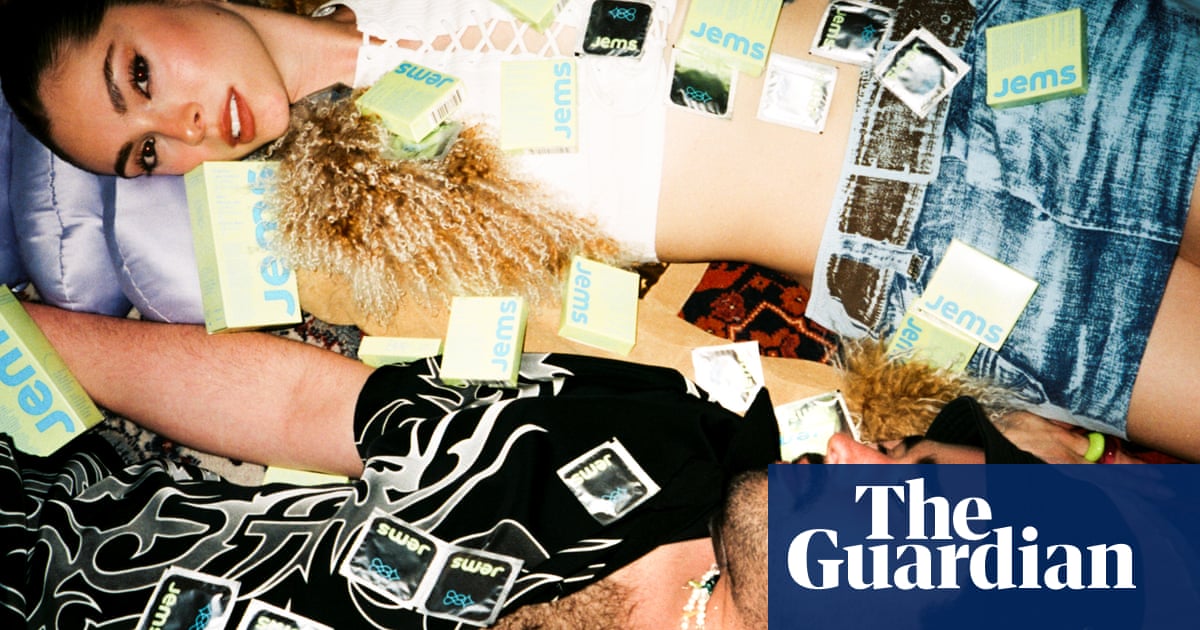The pill put condoms out of style – now fashion designers are reviving a flaccid market - 5 minutes read

For Jean Paul Gaultier, fashion’s greatest creation is not the bra, the skirt or even a conical bra. “My only regret is not having invented the condom, the most beautiful item of clothing,” he told a journalist after the death of his partner Francis Menuge in 1990 following an HIV diagnosis. (The Frenchman confirmed the quote when interviewed by the Guardian in 2021.)
But Gaultier, beloved for his corsets and Madonna collaborations, isn’t the only one interested in unwrapping this intimate “garment”. The prevalence of condoms in fashion is ballooning, with designer collaborations and a new generation of innovative brands aiming to disrupt a once-flaccid, often unsexy market with more effective, inclusive and aesthetic designs. For his spring/summer 2023 show, Diesel creative director Glenn Martens partnered with Durex on a capsule collection that quickly went viral. Saint Laurent also sells £5 rubbers, while Neil Barrett offers a printed leather condom case.
Riffing off the house’s slogan, the Diesel collection featured T-shirts emblazoned with “For Sucsexful Living”, with 200,000 co-branded condom boxes strewn across the catwalk. “The scale was meant to symbolise the significance of the topic and the continued need for communities to rally around individual freedom,” says Martinne Geller, director of media relations at Durex’s parent company, Reckitt Benckiser, noting that 30,000 condoms were also given away in Diesel stores worldwide as part of the campaign.
Taking the trend from the catwalk to the sidewalk, stunt dresser Julia Fox was also photographed last month with a a bag, boots and tube top made of condoms. A week later, Rihanna, who is pregnant with her second child, roguishly nodded to Naomi Campbell’s 2003 Use a Condom tank-top by wearing an oversized T-shirt from her own Savage x Fenty brand that bore the same slogan.
Perhaps, in a way, the wearable contraceptive is going back to its roots. In Victorian times, condoms were couture; doctors measured a wearer’s penis before ordering in a specific fit. It was only decades later that they were turned into a one-size, ready-to-wear product for the mass market.
Since the introduction of the pill, however, a new capsule collection of contraceptives – coils, rings, implants – have made that function of the condom at least somewhat out of date. Indeed, while they’re in vogue for the world of fashion, they’re becoming more rogue in the real world.Their decline comes from various directions. A 2021 report from Trojan parent company Church and Dwight found that condom use had declined, citing alternate birth control, less fear of HIV, a decrease in levels of sexual activity and increased competition in the market as factors in their decrease. A UK report in 2017 reported that half of young people do not use condoms for sex with new partner, and during the pandemic there was a 40% drop in sales across the globe.
A Saint Laurent condom for a fiver.But could fashion’s frisson with the humble rubber ignite a revival? There are hints it’s already under way, with everything from politics to a sudden spike in STIs having an impact. A recent survey found that after of Roe v Wade was overturned in the US, 74% of respondents said they were more likely to use a condom. Combine this with Gen Z having less, but safer, sex and rising health concerns surrounding hormonal contraception, and you’ve got fertile ground for a condom revival.
Brands attempting to break old-fashioned taboos include the chic sex-care startup Roam, which recently released some of the first skin tone condoms, made with Fairtrade natural latex, 40% less plastic than their rivals, and which are vegan and cruelty-free.
On a similar tip, One Condoms have released custom-fit versions designed for safe anal sex.
Most fashionable is Jems, backed by social media posts featuring memes about “eating ass”, infographics on ethical porn search terms, Y2K-style images and genuinely sexy packaging. “The goal,” says co-founder Yasemin Emory, “was to create a package that was covetable and makes you feel comfortable checking out at the store.”
Jems has launched its own range of Use a Condom tees, and a very of-the-moment crochet holder for a rubber and a lighter.
“Gen Z is such an open and conversational generation that undoubtedly is more comfortable talking about sex than prior generations,” Emory says. “If we continue to normalise these conversations and discuss safer sex, condom use will continue to have a resurgence.”
But why are clothing brands getting involved? “A huge part of fashion has and always will be to provoke, push the envelope, and make a statement,” says Emory. Perhaps it’s part of fashion’s viral frivolity, another way to shock; or, maybe, it’s connected to a latex revival and the trend for sheer fabrics, drawing on the condom’s actual fabrication and feel.
skip past newsletter promotionSign up to Fashion StatementStyle, with substance: what's really trending this week, a roundup of the best fashion journalism and your wardrobe dilemmas solvedPrivacy Notice: Newsletters may contain info about charities, online ads, and content funded by outside parties. For more information see our Privacy Policy. We use Google reCaptcha to protect our website and the Google Privacy Policy and Terms of Service apply.after newsletter promotionThe cynic, of course, will see this as another fashion fad, viewing Saint Laurent’s five-quid condom as the new luxury mass-market, entry-level keyring; another silly craze to empty (and, perhaps, restuff) wallets. Then again, if we go back to Gaultier, there is something beautiful about the condom as an object; while humble in its form, it’s a precursor to natural pleasure. If the trend can help make safe sex stylish, it might be a truly seminal moment.
To read the complete version of this newsletter – complete with this week’s trending topics in The Measure and your wardrobe dilemmas solved – subscribe to receive Fashion Statement in your inbox every Thursday.
Source: The Guardian
Powered by NewsAPI.org